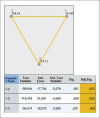Prevalence of Incidental Gynecomastia by Chest Computed Tomography in Patients with a Prediagnosis of COVID-19 Pneumonia
- PMID: 33870118
- PMCID: PMC8025726
- DOI: 10.4274/ejbh.galenos.2021.6251
Prevalence of Incidental Gynecomastia by Chest Computed Tomography in Patients with a Prediagnosis of COVID-19 Pneumonia
Abstract
Objective: In this study, we aimed to determine the prevalence of gynecomastia by evaluating computed tomography (CT) images of male patients who were admitted to our hospital during the coronavirus disease-2019 (COVID-19) pandemic.
Materials and methods: This study included a total of 1,877 patients who underwent chest CT for prediagnosis of COVID-19 pneumonia between March 15th and May 15th, 2020. All images were evaluated for the presence of gynecomastia. Gynecomastia patterns were evaluated according to morphological features, and diagnoses were made by measuring the largest glandular tissue diameter. Statistical analysis was performed with IBM SPSS software version 25.0.
Results: The prevalence of gynecomastia was 32.3%. In terms of pattern, 22% were nodular, 57% were dendritic, and 21% were diffuse glandular gynecomastia. A significant correlation was found between age and gynecomastia pattern (p<0.001). The incidence of nodular, dendritic, and diffuse glandular gynecomastia increased with advancing age. A significant difference was found in the analysis of the correlation between age groups and glandular tissue diameters (p<0.001). With an increase in glandular tissue diameter, the gynecomastia pattern changed from a nodular to a diffuse glandular pattern.
Conclusion: In our study, gynecomastia diagnosis was made through axial CT images. Although CT should not replace mammography and ultrasonography for clinical diagnosis of gynecomastia, chest CT scans can be used to evaluate patients with suspected gynecomastia.
Keywords: COVID-19; CT; Male breast; dendritic pattern; diffuse glandular pattern; gynecomastia; nodular pattern.
©Copyright 2021 by Turkish Federation of Breast Diseases Associations.
Conflict of interest statement
Conflict of Interest: No conflict of interest was declared by the authors.
Figures






Similar articles
-
Computed tomography-based radiological gynecomastia in SBMA as an independent differential diagnostic biomarker: a retrospective study.Neurol Sci. 2025 Feb;46(2):783-789. doi: 10.1007/s10072-024-07820-1. Epub 2024 Oct 29. Neurol Sci. 2025. PMID: 39467933
-
Incidental Gynecomastia on Thoracic Computed Tomography in Clinical Practice: Characteristics, Radiologic Features, and Correlation With Possible Causes in South Korean Men.Am J Mens Health. 2020 May-Jun;14(3):1557988320908102. doi: 10.1177/1557988320908102. Am J Mens Health. 2020. PMID: 32456508 Free PMC article.
-
Quantitative and Morphological Assessment of Computed Tomography-depicted Gynecomastia in Spinal and Bulbar Muscular Atrophy.Acad Radiol. 2022 Nov;29(11):1692-1699. doi: 10.1016/j.acra.2022.02.003. Epub 2022 Mar 1. Acad Radiol. 2022. PMID: 35246377
-
Imaging in gynecomastia.Andrology. 2021 Sep;9(5):1444-1456. doi: 10.1111/andr.13051. Epub 2021 Jun 10. Andrology. 2021. PMID: 34033252 Review.
-
Comparison of the computed tomography findings in COVID-19 and other viral pneumonia in immunocompetent adults: a systematic review and meta-analysis.Eur Radiol. 2020 Dec;30(12):6485-6496. doi: 10.1007/s00330-020-07018-x. Epub 2020 Jun 27. Eur Radiol. 2020. PMID: 32594211 Free PMC article.
Cited by
-
Cross-chest liposuction plus gland resection through single minimal incision for management of grade I/II gynecomastia.BMC Surg. 2025 Jul 3;25(1):256. doi: 10.1186/s12893-025-02980-z. BMC Surg. 2025. PMID: 40611156 Free PMC article.
-
Gynecomastia on Thoracic Computed Tomography.Cureus. 2024 Jan 2;16(1):e51509. doi: 10.7759/cureus.51509. eCollection 2024 Jan. Cureus. 2024. PMID: 38304650 Free PMC article.
References
-
- Bilgen GI. Erkek memesi. İçinde: Oktay A, editör. Meme hastalıklarında görüntüleme. 2nd ed. Ankara: Dunya Tıp Kitabevi. 2020:p.351–364.
-
- Harvey J, March DE. Making the diagnosis: a practical guide to breast imaging. 1st ed. Philadelphia, Pennsylvania, USA: Elsevier Health Sciences. 2012.
-
- Klang E, Kanana N, Grossman A, Raskin S, Pikovsky J, Sklair M, et al. Quantitative CT assessment of gynecomastia in the general population and in dialysis, cirrhotic, and obese patients. Acad Radiol. 2018;25:626–635. - PubMed
-
- Klang E, Rozendorn N, Raskin S, Portnoy O, Sklair M, Marom EM, et al. CT measurement of breast glandular tissue and its association with testicular cancer. Eur Radiol. 2017;27:536–542. - PubMed
LinkOut - more resources
Full Text Sources
Other Literature Sources
